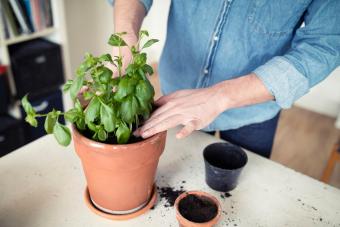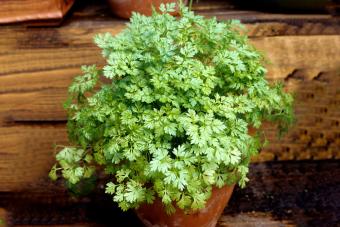
Looking to dress up your indoor space with some low-maintenance, multipurpose plants? An indoor herb garden can beautify your living area while also providing convenient and easy access to fresh culinary herbs, many of which also provide medicinal benefits. Which of the best herbs to grow indoors will you choose? Whether you start with just a few herbs or you go big by growing all 15 options listed below, your indoor herb plants are sure to spice up your life.
Basil

Wish you could enjoy fresh basil year-round? When you grow it indoors, you absolutely can. Basil won't survive a frost outdoors, but it'll thrive in a sunny indoor environment. It's easy to grow basil from seed, and you can also propagate basil cuttings in water. Basil seedlings and larger plants need at least six hours of sun per day, so it's best to place them in a sunny window that faces south. If you don't have an area that is sunny enough, you can also grow basil (and other herbs) under grow lights.
Chervil

Looking for an herb that can thrive indoors with a bit less sunlight than most? Chervil is a great option, as it needs only about four hours of sunlight per day. This herb, which is commonly used in French cuisine, prefers cool (but not freezing) temperatures, so it tends to grow much better and last longer indoors than outdoors. If you group all of your indoor herbs together, place chervil toward the center where other plants will shade it a bit. It's best to start chervil from seed.
Chives

Chives are an easy-to-grow-from-seed herb that thrives indoors. Armed with these tips for growing chives, you'll be able to plant chives indoors once and keep them going indefinitely. You can also easily transplant outdoor chives indoors. Chives prefer 6+ hours of sun per day, but will grow with less. Chives spread easily, so you'll probably even need to divide them periodically. That means you can share the herb love with friends who would like to get started growing their own herb garden.
Cilantro

Cilantro is a great herb to grow indoors. It prefers to grow in cool conditions, so if you live in a warm climate this is really the only way you'll have reliable access to fresh cilantro. Sprinkle this herb in the homemade salsa you make using the fresh tomatoes you grow in your garden or select at the farmer's market. It needs six or more hours of sunlight per day, so place it in a very sunny window or use a grow light. It does not transplant well, so you'll want to root cuttings or start cilantro from seed.
Dill

Looking to preserve some of your veggie harvest by pickling? You'll need access to a lot of dill. Fortunately, it's very easy to grow, harvest, and use dill. It's generally easier to start dill from seed rather than from cutting. Dill will grow best indoors in a sunny window where it gets six or more hours of sun each day, or under a grow light that stays on for around 12 hours per day. You won't want to grow mammoth dill indoors because it gets huge, but any other variety should work well.
Lemon Balm

Can you squeeze another herb into the area in front of your sunniest window? Make way for lemon balm. This sun-loving herb is easy to grow indoors, as long as you provide it with at least six hours (preferably more) of sun each day. This aromatic herb is in the mint family, so its flavor is a unique combination of lemon and mint. It is a popular herb to use in tea, and can also be substituted in any recipe that calls for mint.
Mint

No indoor herb garden would be complete without at least one mint plant. If you love mint tea and/or cooking with this fragrant herb, you might actually want to include several types of mint in your collection of indoor herbs. Sweet mint is a must-grow, but so are peppermint, apple mint, chocolate mint, and more. Mint grows well indoors. Mint will grow just fine with five hours of sunlight per day, though more is also fine. It's not picky.
Oregano

No indoor herb garden is complete without oregano, a wonderful herb that tastes distinctly different from its dried form when eaten fresh. Fortunately, it's very easy to grow oregano indoors. It's quick and easy to start oregano plants from seed, and it's super simple to root oregano stems in water. No matter how you start your indoor oregano plants, be sure to place them in a location where they'll get at least six hours of sunlight each day, preferably even more.
Parsley

Want to grow a multipurpose herb indoors that you can snip and toss into all kinds of dishes? Parsley is a perfect choice. Parsley grows very well indoors, as long as it gets plenty of light. Like most herbs, parsley needs at least six hours of sunlight per day. This herb will thrive in an indoor environment, as it does not like the extreme heat of summer. You can root cuttings in water or start parsley from seed. If you go the seed route, be prepared to wait several weeks for the seeds to germinate.
Rosemary

Wouldn't you love to have a fresh rosemary plant in your kitchen to harvest any time you want? Rosemary is such a flavorful addition to all kinds of delightful Mediterranean dishes, as well as basic meats and vegetables. It's easy to grow rosemary indoors, especially if you start from rooted cuttings. You can also start it from seed, but germination can take quite a while. Rosemary plants need a minimum of six (preferably more) hours of sunlight each day in order to thrive.
Sage

Known for its unique aroma, sage might be the most important ingredient in Thanksgiving stuffing. When you grow it in your indoor herb garden, you won't have to wait for a special occasion to cook with fresh sage or brew some sage tea. It's easy to grow sage indoors from seeds or cuttings, as long as you can place it in a sunny window that gets six or more hours of sunlight each day.
Savory

Looking to add something a bit unusual to your herb garden? Savory is a wonderful option with many culinary uses. Summer savory is an annual and winter savory is a perennial; both grow well indoors. Not surprisingly, given their name, both types are wonderful additions to savory dishes. They need a bare minimum of six hours of sun per day; eight or more is ideal. You can start either kind from seeds or cuttings.
Tarragon

Do you love the flavor of tarragon-infused vinegar? You can make your own on the cheap when you grow tarragon in your indoor herb garden. Tarragon is notoriously difficult to start from seed, so you'll need to root a cutting or purchase a plant start from a nursery. It'll thrive indoors as long as it is positioned to get at least six hours of sunlight on a daily basis.
Thyme

Round out your indoor herb garden with thyme, a perennial (literally) favorite. Like most herbs, thyme needs at least six hours of sunlight on a daily basis in order to thrive. It can be challenging to grow thyme from seed, but it can easily be grown from cuttings or even by dividing new growth from existing plants. It's often paired with rosemary, sage, and parsley in recipes, so you'll have a lot of culinary options when you have all four of these herbs growing in your home.
Key Tips for Your Indoor Herb Garden
No matter which herbs you plant in your indoor herb garden, be sure to pot them in well-draining soil. It's best to use potting soil that's intended for indoor use and to fertilize your herbs periodically with a liquid, slow-release fertilizer designed for houseplants. You may also want to invest in some grow lights, especially if your access to sunny (ideally south-facing) windows is limited. Keep in mind that to a plant, 13 hours under a grow light equates to six hours of time in the sun.







